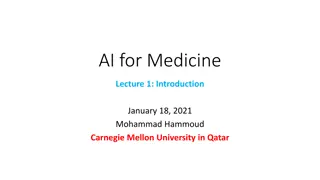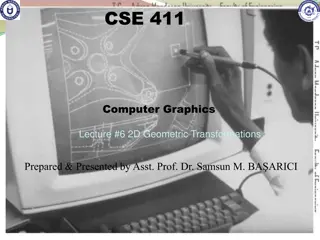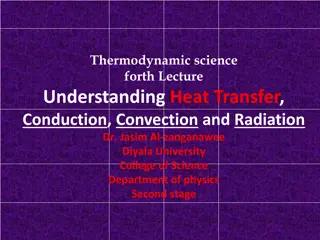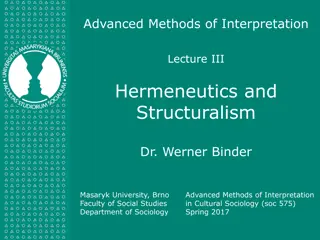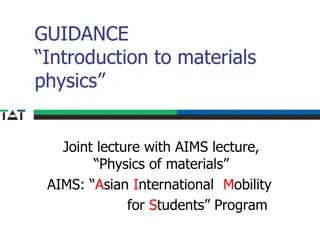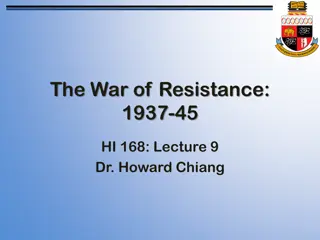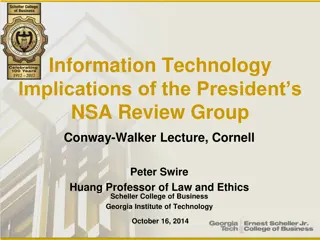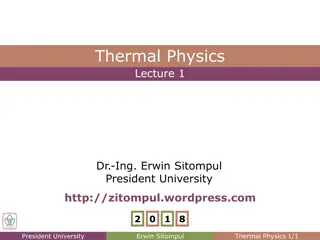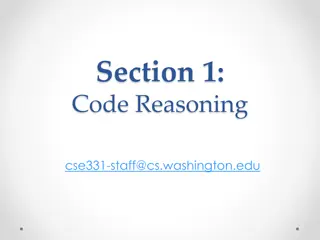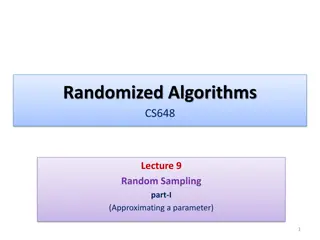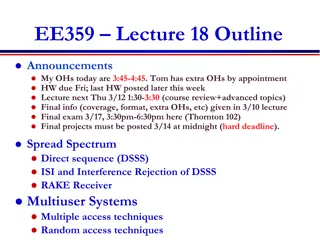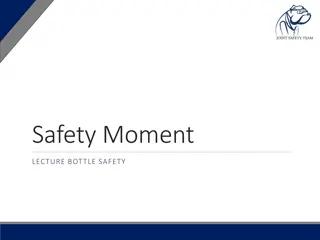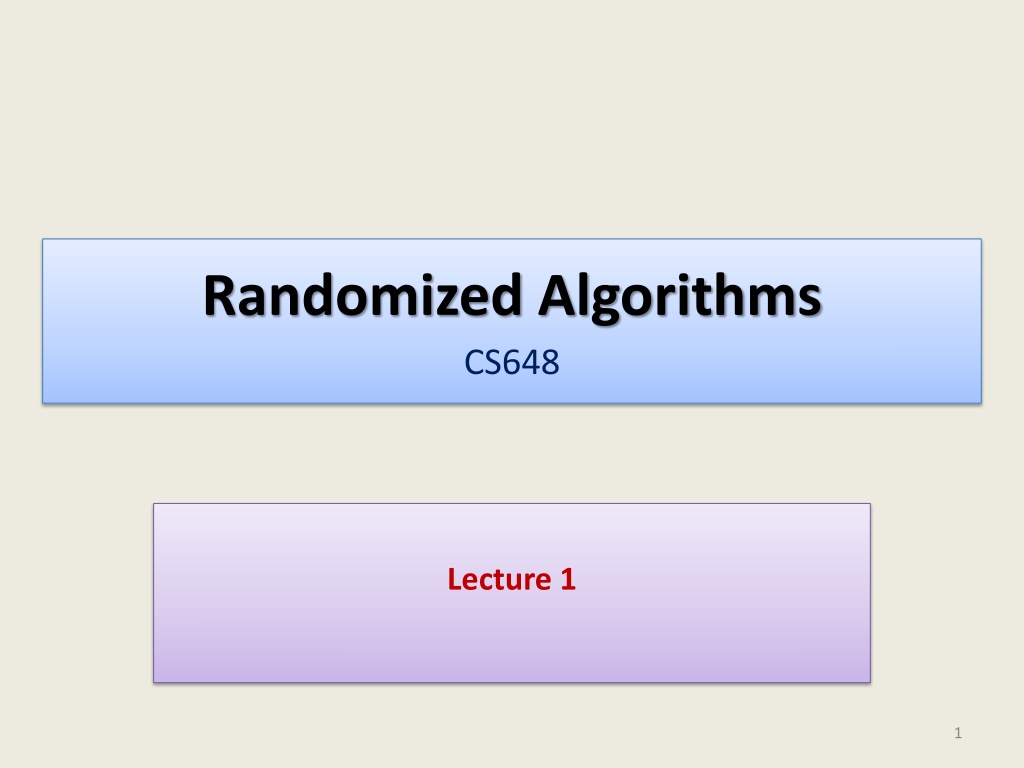
Exploring Randomized Algorithms in CS648 and Examples
Discover the world of randomized algorithms in CS648, including the definition, structure, and examples like Approximate Median and Randomized QuickSort. Dive into the concepts, motivations, and running times of both deterministic and randomized algorithms, gaining insights into the fascinating realm of randomness in computing.
Download Presentation

Please find below an Image/Link to download the presentation.
The content on the website is provided AS IS for your information and personal use only. It may not be sold, licensed, or shared on other websites without obtaining consent from the author. If you encounter any issues during the download, it is possible that the publisher has removed the file from their server.
You are allowed to download the files provided on this website for personal or commercial use, subject to the condition that they are used lawfully. All files are the property of their respective owners.
The content on the website is provided AS IS for your information and personal use only. It may not be sold, licensed, or shared on other websites without obtaining consent from the author.
E N D
Presentation Transcript
Randomized Algorithms CS648 Lecture 1 1
Overview of the lecture What is a randomized algorithm ? Motivation The structure of the course 2
Deterministic Algorithm Output Input Algorithm The output as well as the running time are functions only of the input. 4
Randomized Algorithm Random bits Output Input Algorithm The output or the running time are functions of the input and random bits chosen . 5
Approximate median Definition: Given an array A[] storing n numbers and > 0, compute an element whose rank is in the range [(1- )n/2, (1+ )n/2]. A Randomized Algorithm: 1. Select a random sample S of O( 1 log n) elements from A. 2. Sort S. 3. Report the median of S. Running time: O(1 log n loglog n) The output is an -approximate median with probability ? ?. For n ~ a million, the error probability is ?? ??. 7
QuickSort(?) QuickSort(?) { If (|?|>1) (?<?, ?>?) return( Concatenate(QuickSort(?<?), ?, QuickSort(?>?)) } Pick and remove an element ? from ?; Partition(?,?); 9
QuickSort(?) When the input ? is stored in an array? QuickSort(?,?, ?) { If (? < ?) QuickSort(?,?, ? ?); QuickSort(?,? + ?, ?) } ? ?[?]; ? Partition(?,?,?,x); Average case running time: O(n log n) Worst case running time: O(??) Distribution sensitive: Time taken depends upon the initial permutation of ?. 10
Randomized QuickSort(?) When the input ? is stored in an array? QuickSort(?,?, ?) { If (? < ?) QuickSort(?,?, ? ?); QuickSort(?,? + ?, ?) } Distribution insensitive: Time taken does not depend on initial permutation of ?. Time taken depends upon the random choices of pivot elements. 1. For a given input, Expected(average) running time: O(n log n) 2. Worst case running time: O(??) ? ?[?]; ? Partition(?,?,?,x); an element selected randomly uniformly from ?[?..?]; 11
Types of Randomized Algorithms Randomized Las Vegas Algorithms: Output is always correct Running time is a random variable Example: Randomized Quick Sort Randomized Monte Carlo Algorithms: Output may be incorrect with some probability Running time is deterministic. Example: Randomized algorithm for approximate median 12
MOTIVATION FOR RANDOMIZED ALGORITHMS 13
Randomized algorithm for a problem is usually simpler and more efficientthan its deterministic counterpart. 14
Example 1: Sorting Deterministic Algorithms: Heap sort Merge Sort Randomized Las Vegas algorithm: Randomized Quick sort Randomized Quick sort almost always outperforms heap sort and merge sort. Probability[running time of quick sort exceeds twice its expected time] < ? ?????? ? For ?= 1 million, this probability is ?? ?? 15
Example 2: Smallest Enclosing circle Problem definition: Given n points in a plane, compute the smallest radius circle that encloses all n point. Applications: Facility location problem Best deterministic algorithm : [Megiddo, 1983] O(n) time complexity, too complex, uses advanced geometry Randomized Las Vegas algorithm: [Welzl, 1991] Expected O(n) time complexity, too simple, uses elementary geometry 16
Example 3: minimum Cut Problem definition: Given a connected graph G=(V,E) on n vertices and m edges, compute the smallest set of edges that will make G disconnected. Best deterministic algorithm : [Stoer and Wagner, 1997] O(mn) time complexity. Randomized Monte Carlo algorithm: [Karger, 1993] O(m log n) time complexity. Error probability: ? ? for any ? that we desire 17
Example 4: Primality Testing Problem definition: Given an n bit integer, determine if it is prime. Applications: RSA-cryptosystem, Algebraic algorithms Best deterministic algorithm : [Agrawal, Kayal and Saxena, 2002] O(??) time complexity. Randomized Monte Carlo algorithm: [Rabin, 1980] O(k ??) time complexity. Error probability: ? ? for any ? that we desire For ?= 50, this probability is ?? ?? 18
UNCERTAINTY ASSOCIATED WITH RANDOMIZED ALGORITHMS IS IT REALLY A SERIOUS ISSUE ? 19
A real Fact [A study by Microsoft in 2008] If we run a CPU for 5 days, probability of its failure during this interval is 1/330. Probability[a CPU fails in one second] > ?? ? Compare this probability with the failure (or exceeding the running time) probability of various randomized algorithms mentioned earlier. The reference of the study is: E.B. Nightingale, J.P. Douceur, Vince Orgovan. Cycles, Cells, and Platters: An Empirical Analysis of Hardware Failures on a Million PCs. In Proceedings of EuroSys 2011. (awarded Best Paper ). A copy is available on the course webpage as well. 20
Prerequisites Fundamentals of Data structures Fundamentals of the design and analysis of Algorithms Adequate programming skills (in C++) Elementary probability (12th standard) Ability to work hard Commitment to attend classes 22
Marks Breakup Assignments: 40% Programming as well as theoretical. To be done in groups of 2. Mid Semester Exam: 30% End Semester Exam: 30% Passing criteria: At least 25% marks in both the exam (Total 15 out of 60) If a student scores less than 50% marks in first mid semester exam, he/she must attend all classes for the rest of the course. 23
Contact Details Office: 307, Department of CSE Office Hours: Every week day 12:30PM-1:00PM and 5:30PM-6:00PM Course website will be maintained at moodle.cse.iitk.ac.in 24




